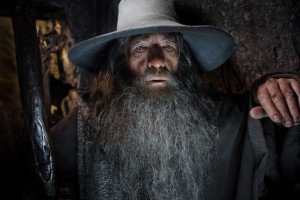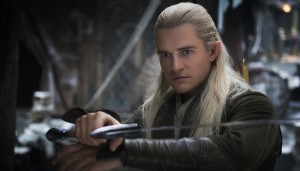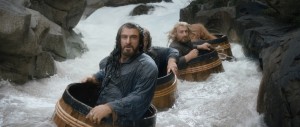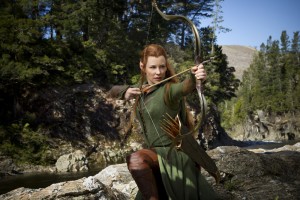Ian McKellen, Martin Freeman, and Richard Armitage return to continue their quest. J.P. gives us his take on the 2nd film in the latest “The Hobbit” series.
“THE HOBBIT: THE DESOLATION OF SMAUG”
Warner Bros. Pictures
MPAA Rating: PG-13 for “intense perilous sequences, some disturbing images and brief strong language”
Run Time: 156 minutes (Approx.)

Studio Synopsis:
From Academy Award®-winning filmmaker Peter Jackson comes “The Hobbit: The Desolation of Smaug,” the second in a trilogy of films adapting the enduringly popular masterpiece The Hobbit, by J.R.R. Tolkien.
The three films tell a continuous story set in Middle-earth 60 years before “The Lord of the Rings,” which Jackson and his filmmaking team brought to the big screen in the blockbuster trilogy that culminated with the Oscar®-winning “The Lord of the Rings: The Return of the King.”
“The Hobbit: The Desolation of Smaug” continues the adventure of the title character Bilbo Baggins as he journeys with the Wizard Gandalf and thirteen Dwarves, led by Thorin Oakenshield, on an epic quest to reclaim the Lonely Mountain and the lost Dwarf Kingdom of Erebor.
Having survived the beginning of their unexpected journey, the Company continues East, encountering along the way the skin-changer Beorn and a swarm of giant Spiders in the treacherous forest of Mirkwood. After escaping capture by the dangerous Wood-elves, the Dwarves journey to Lake-town, and finally to the Lonely Mountain itself, where they must face the greatest danger of all—a creature more terrifying than any other; one which will test not only the depth of their courage but the limits of their friendship and the wisdom of the journey itself—the Dragon Smaug.
Ian McKellen returns as Gandalf the Grey, with Martin Freeman in the central role of Bilbo Baggins, and Richard Armitage as Thorin Oakenshield. The international ensemble cast is led by Benedict Cumberbatch, Evangeline Lilly, Lee Pace, Luke Evans, Ken Stott, James Nesbitt, and Orlando Bloom as Legolas. The film also stars (in alphabetical order) John Bell, Manu Bennett, Jed Brophy, Adam Brown, John Callen, Ryan Gage, Mark Hadlow, Peter Hambleton, Stephen Hunter, William Kircher, Lawrence Makoare, Sylvester McCoy, Graham McTavish, Dean O’Gorman, Mikael Persbrandt, and Aidan Turner.
The screenplay for “The Hobbit: The Desolation of Smaug” is by Fran Walsh & Philippa Boyens & Peter Jackson & Guillermo del Toro, based on the novel by J.R.R. Tolkien. Jackson also produced the film, together with Carolynne Cunningham, Zane Weiner and Fran Walsh. The executive producers are Alan Horn, Toby Emmerich, Ken Kamins and Carolyn Blackwood, with Philippa Boyens and Eileen Moran serving as co-producers.
The creative behind-the-scenes team is led by director of photography Andrew Lesnie, production designer Dan Hennah, conceptual designers Alan Lee and John Howe, editor Jabez Olssen, and hair and makeup designer Peter Swords King. The costumes are designed by Bob Buck, Ann Maskrey and Richard Taylor. Taylor is also overseeing the design and production of armour, weapons, creatures and special makeup, which are once again being made by the award-winning Weta Workshop. Weta Digital is taking on the visual effects for the film, led by senior visual effects supervisor Joe Letteri. The visual effects supervisor is Eric Saindon, with David Clayton and Eric Reynolds serving as animation supervisors. The music is by Howard Shore.
Under Jackson’s direction, “The Hobbit: The Desolation of Smaug” was shot in 3D 48 frames-per-second and will be released in High Frame Rate 3D (HFR 3D) in select theaters, other 2D and 3D formats, and IMAX®. Production took place at Jackson’s own facilities in Miramar, Wellington, and on location around New Zealand. Post production took place at Park Road Post Production in Wellington.
New Line Cinema and Metro-Goldwyn-Mayer Pictures Present a WingNut Films Production, “The Hobbit: The Desolation of Smaug.” “The Hobbit: The Desolation of Smaug” is a production of New Line Cinema and Metro-Goldwyn-Mayer Pictures (MGM), with New Line managing production. The film opens nationwide on December 13, 2013. Warner Bros. Pictures is handling worldwide theatrical distribution, with select international territories as well as all international television distribution being handled by MGM.
[youtuber youtube=’http://www.youtube.com/watch?v=lfflhfn1W-o’]
J.P.’s Take:
“The Hobbit: The Desolation of Smaug” is true to its genre, complete with the typical memes found in countless successful fantasy films. Doom and gloom lurking through out dark forests and dead castles with fierce creatures abound. Present are elves, dwarves, an old wizard and one of the coolest CGI rendered dragons named Smaug (balefully voiced by the sensational Benedict Cumberbatch).
Once again the merry band of dwarves, led by mighty Thorin Oakenshield (Richard Armitage), drags along an uneager Bilbo Baggins (Martin Freeman) as they prepare themselves for another torturous ordeal. They are on a quest to reclaim their homeland found at LonelyMountain, yet the key to their salvation requires them to retrieve the Arkenstone. By no means is this an easy feat: the dwarf pack is tasked with traversing dizzying mountain cliffs, dodging Orc attacks and escaping the clutches of Elven warriors. Nothing the troops haven’t dealt with before in the forerunner, “An Unexpected Journey.” However “Desolation” differs in mood and pacing achieving a bleaker, thoroughly told tale, due to the building up of a confrontation with dark malevolent forces. There are scenes of flashbacks that you’ll have to pay close attention to, which allows “Desolation” to pick up where the first left off.

Peter Jackson has the wherewithal for capturing the very essence of a genres mood. When it comes to epic battle scenes, Jackson doesn’t let up on the action; in fact some of the best scenes are in the first half of the film. One key scene involves the army of dwarves whom trek into a dark forest, where they encounter bus sized spiders that creep their way around trees and webbing. Not being a huge fan of spiders myself, those moments produced some creepingly eerie atmospherics for me and anyone viewing that scene in 3D. Other fun adventurous scenes stem from moments during the dwarves escape from the dungeons of the Elven kingdom. The pint sized brood, with the help of Bilbo, manages to exit the castle by hiding in wine barrels that are then flushed out through a hatch in the floor of the docks. From there that moment takes on a theme park ride quality, as they float down roaring rapids fending off the alerted Elves and Orcs. The acrobatic performances here involve the characters bouncing off trees, rock faces and each other like parkour runners. Bilbo’s story also comes into play here, with cut-ins of his memories of the past adventure propelling him onward.

I felt the cast portrayed their characters vividly. Evangeline Lilly (Kate from “Lost”) as the Elven warrioress Tauriel stands out in the crowd, as she rivals Scarlett Johansson’s Black Widow character in “The Avengers.” Her performance is something I encourage viewers to witness for themselves. A nearly unrecognizable Orlando Bloom is somewhat low key as Legolas, until he comes into contact with the mini might dwarf pack. His heroic side shines through as the third act trains along. Cumberbatch lends his broody vocals to the dragon Smaug, which looks as though it were ripped right from ancient medieval texts. His presence is not only seen, but felt through his deep growling inflections. Not to forget Ian McKellen, who is in top form as Gandalf. The remainder of the cast, which are too many to list, all have their integral roles within this realm and are worthy of viewing.
What J. R. R. Tolkien expressed in his volume of novels is transplanted here in Peter Jackson’s epic vision. And I’m sure if Tolkien were alive today, he’d give Jackson and crew his blessing on the project. There is an awestruck quality when viewing “The Desolation of Smaug,” especially when experienced through the lenses of 3D glasses, sometimes overwhelmingly so. The imagery is presented on a massive scale with structures protruding through fog and clouds. Sweeping shots of natural even CGed landscapes feel seamless and very much part of the fully realized world it belongs to. There is also elegance in the design of many of the kingdoms, costumes and weaponry. Again, it is something that feels as though it were extracted from Tolkien’s imagination.
The only real hiccup here is the anticlimactic ending. I simply expected a better build up to what would otherwise be a cliff hanger. But we know where this is heading because part two is basically a bridge gap for the third film in “The Hobbit” anthology. Movies like this prompt me to go back and read the source material just to find the little nuances the films either toss or keep. So I looking forward to the next installment just to learn more about this world Tolkien has created.
